
Mars Pathfinder Instrument Descriptions
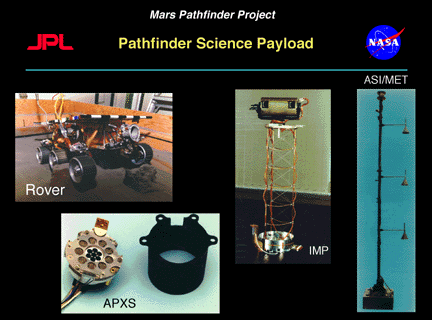
Imager For Mars Pathfinder (IMP)
The Imager For Mars Pathfinder is a stereo imaging system with color
capability provided by a set of selectable filters for each of the two camera
channels. It has been developed by a team lead by the University
Of Arizona with contributions from the Lockheed
Martin Group, Max Planck Institute
For Aeronomy in Lindau, Germany, the Technical
University Of Braunschweig in Germany and the Ørsted
Laboratory, Niels Bohr Institute for Astronomy, Physics and Geophysics
in Copenhagen, Denmark. It consists of three physical subassemblies: (1)
camera head (with stereo optics, filter wheel, CCD and pre-amp, mechanisms
and stepper motors); (2) extendable mast with electronic cabling; and (3)
two plug-in electronics cards (CCD data card and power supply/motor drive
card) which plug into slots in the Warm Electronics Box within the lander.
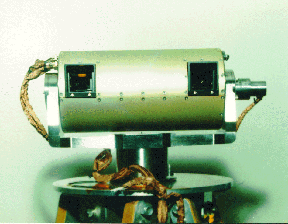
Figure 1. Close-Up of the IMP Camera Head
Azimuth and elevation drives for the camera head are provided by stepper
motors with gear heads, providing a field of regard of ±180 degrees
in azimuth and +83 degrees to -72 degrees in elevation, relative to lander
coordinates. The camera system is mounted at the top of a deployable mast,
a continuous longeron, open-lattice type provided by Able Manufacturing,
Inc. When deployed, the mast provides an elevation of 1.0 m above the lander
mounting surface.
The focal plane consists of a CCD mounted at the foci of two optical paths
where it is bonded to a small printed wiring board, which in turn is attached
by a short flex cable to the preamplifier board. The CCD is a front-illuminated
frame transfer array with 23 micrometer square pixels. Its image section
is divided into two square frames, one for each half of the stereo FOV's.
Each has 256x256 active elements. A 256x512 storage section (identical to
the imaging section) is located under a metal mask. The imp focal plane
and electronics are nearly identical copies of the comparable subsystem
employed in the Huygens Probe Descent Imaging Spectroradiometer (DISR),
using the Loral 512X512 CCD.
The stereoscopic imager includes two imaging triplets, two fold mirrors
separated by 150 mm for stereo viewing, a 12-space filter wheel in each
path, and a fold prism to place the images side-by-side on the CCD focal
plane. Fused silica windows at each path entrance prevent dust intrusion.
the optical triplets are an f/10 design, stopped down to f/18 with 23-mm
effective focal lengths and a 14.4 degree field of view. The pixel instantaneous
field of view is one milliradian. The filter wheel four pairs of atmospheric
filters, two pairs of stero filters, eleven individual geologic filters
(which, when combined with the two pairs of stereo filters, result in thirteen
distinct geologic filters) and one diopter or close-up lens, designed to
acquire images of magnetic, wind-blown dust which adheres to a small magnet
located on the IMP tip plate.
Full panoramas of the landing site are acquired during the mission using
the stereo baseline provided by the camera optics. Additionally, monoscopic
panoramas are acquired both prior and subsequent to the mast deployment,
yielding vertically displaced stereo pairs with approximately 80 cm baseline.
Images of a substantial portion of the visible surface are acquired in multispectral
images with as many as eight spectral bands.
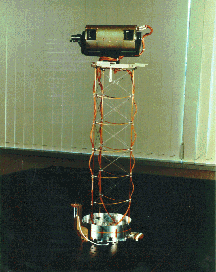
Figure 2. IMP Deployed On The Able Mast
A number of atmospheric imvestigations are carried out using imp images.
aerosol opacity is measured periodically by imaging the Sun through two
narrow-band filters. Dust particles in the atmosphere are characterized
by observing Phobos at night. Water vapor abundance is measured by imaging
the Sun through filters in the water vapor absorption band and in the spectrally
adjacent continuum. Images of wind socks located at several heights above
the surrounding terrain are used to assess wind speed and direction.
A magnetic properties investigation
is included as part of the IMP investigation. A set of magnets of differing
field strengths will be mounted to a plate and attached to the lander. Images
taken over the duration of the landed mission are used to determine the
accumulation of magnetic species in the wind-blown dust. Multispectral images
of these accumulations may be used to differentiate among likely magnetic
minerals.
The IMP investigation also includes the observation of wind direction using
a small wind sock mounted above a reference grid, and a calibration and
reference target mounted to the lander.
Alpha Proton X-Ray Spectrometer
This instrument is a foreign-provided derivative of instruments flown
on the Russian Vega and Phobos missions and identical to the unit that was
planned for flight on the Russian
Mars '96 missions. Accordingly, the instrument has extensive, applicable
flight heritage. With the mobility provided by the microrover
and a deployment mechanism, the APX Spectrometer not only acquires spectra
from the ubiquitous martian dust, but more importantly, is deployed to distinct
rock outcroppings, thereby analyzing the native rock composition for the
first time. The alpha and proton spectrometer portions are provided by the
Max Planck Institute, Department
of Chemistry, Mainz Germany. The x-ray spectrometer portion is provided
by the University
Of Chicago.
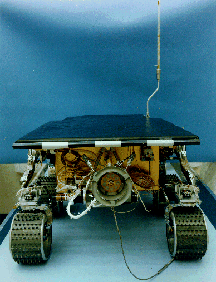
Figure 3. Alpha Proton X-Ray Spectrometer Front View On Rover
This elemental composition instrument consists of alpha particle sources
and detectors for back-scattered alpha particles, protons and X-Rays. The
APX Spectrometer will determine elemental
chemistry of surface materials for most major elements except hydrogen.
The analytical process is based on three interactions of alpha particles
with matter: elastic scattering of alpha particles by nuclei, alpha-proton
nuclear reactions with certain light elements, and excitation of the atomic
structure of atoms by alpha particles, leading to the emission of characteristic
X-Rays. The approach used is to expose material to a radioactive source
that produces alpha particles with a known energy, and to acquire energy
spectra of the alpha particles, protons and X-Rays returned from the sample.
Such an instrument can identify and determine the amounts of most chemical
elements.
The basis of the alpha mode of the instrument is the dependence of the energy
spectrum of alpha particles scattered from a surface on the composition
of the surface material. The method has the best resolving power for the
lighter elements.
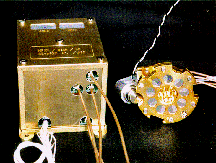
Figure 4. Alpha Proton X-Ray Spectrometer Sensor Head
The proton spectra for alpha particles interacting with elements with atomic
numbers from 9 to 14 are very characteristic of the individual elements,
reflecting the resonance nature of the nuclear interactions involved. The
proton mode allows their detection and measurement.
The addition of a third detector for X-Rays Results in a significant extension
of the accuracy and sensitivity of the instrument, particularly for the
heavier, less abundant elements. Alpha sources produce characteristic X-Rays
for a range of elements, giving an instrument sensitivity that can approach
the ppm level.
The APXS sensor head is mounted external to the Rover
chassis on a deployment mechanism (described below). This mechanism places
the APXS in contact with rock and soil surfaces. The APXS electronics are
mounted within the rover, in a temperature-controlled environment.
APXS Deployment Mechanism
The deployment mechanism supports the APXS under launch and landing loads
and provides a means for positioning the APXS with a single actuator. The
linkage allows the APXS to be placed at a variety of elevations above nominal
ground level and at a variety of rotational orientations. The mounting of
the APXS to the deployment mechanism permits about 20 degrees of compliance
motion as the APXS is placed in contact with the sample. A set of contact
closures on the APXS front aperture ring indicate to the Rover
that the positioning is complete, thereby terminating the positioning motions.
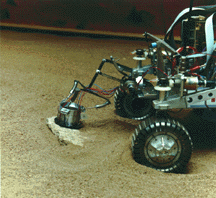
Figure 5. Alpha Proton X-Ray Spectrometer Deployment Mechanism
Atmospheric Structure Instrument/Meterology Package
The ASI/MET is an engineering subsystem which acquires atmospheric information
during the descent of the lander through the atmosphere and during the entire
landed mission. It is implemented by JPL as a facility experiment, taking
advantage of the heritage provided by the Viking mission experiments.
Data acquired during the entry and descent of
the lander permits the reconstruction of profiles of atmospheric density,
temperature and pressure from altitudes in excess of 100 km to the surface.
The accelerometer portion of the ASI is provided by the Attitude And Information
Management subsystem of the lander. It consists of x-, y- and z-axis sensors.
Several gain states are provided to cover the wide dynamic range from the
micro-g accelerations experienced upon entering the atmosphere to the peak
deceleration and landing events in the range of 30 to 50 g's.
The ASI/MET instrument hardware consists of a set of temperature, pressure
and wind sensors and an electronics board for operating the sensors and
digitizing their output signals. Temperature is measured by thin wire thermocouples
mounted on a meteorological mast that is deployed after landing. The location
of one thermocouple is chosed to measure atmospheric temperature during
descent, and three more monitor atmospheric temperatures 25, 50, and 100
cm above the surface during the landed mission. Pressure is measured by
a Tavis magnetic reluctance diaphragm sensor similar to that used by Viking,
both during descent and after landing. The wind sensor employs six hot wire
elements distributed uniformly around the top of the mast. Wind speed and
direction 100 cm above the surface are derived from the temperatures of
these elements.
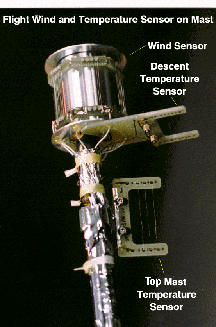
Figure 6. ASI/MET Temperature And Wind Sensors
During entry and descent, the sampling of acceleration,
pressure and temperature data is optimized to the vertical rate of decent
through the atmosphere. After landing, considerable flexibility in data
averaging and sampling is provided to measure the variation of temperature,
surface pressure and wind on short, diurnal, and seasonal time scales over
the life of the mission.
Three wind socks are located at various heights on the meterology mast to
determine the speed and direction of winds at the Pathfinder landing site.
The wind socks will be imaged repeatedly by the IMP.
The orientations of the wind socks will be measured in the images to determine
the wind velocity at three heights above the surface. This information can
then be used to estimate the aerodynamic roughness of the surface in the
vicinity of the lander, and to determine the variation in wind speed with
height. Because the Viking landers had wind sensors at only one height,
such a vertical wind profile has never been measured on Mars. This new knowledge
will help to develop and modify theories for how dust and sand particles
are lifted into the martian atmosphere by winds, for example. Because erosion
and deposition of wind-blown materials has been such an important geologic
process on the surface of Mars, the results of the wind sock experiment
will be of interest to geologists as well as atmospheric scientists.
Return
To The Mars Pathfinder Home Page.
Check out the Mars Pathfinder
Participating Scientists and Facility Instrument Science Team